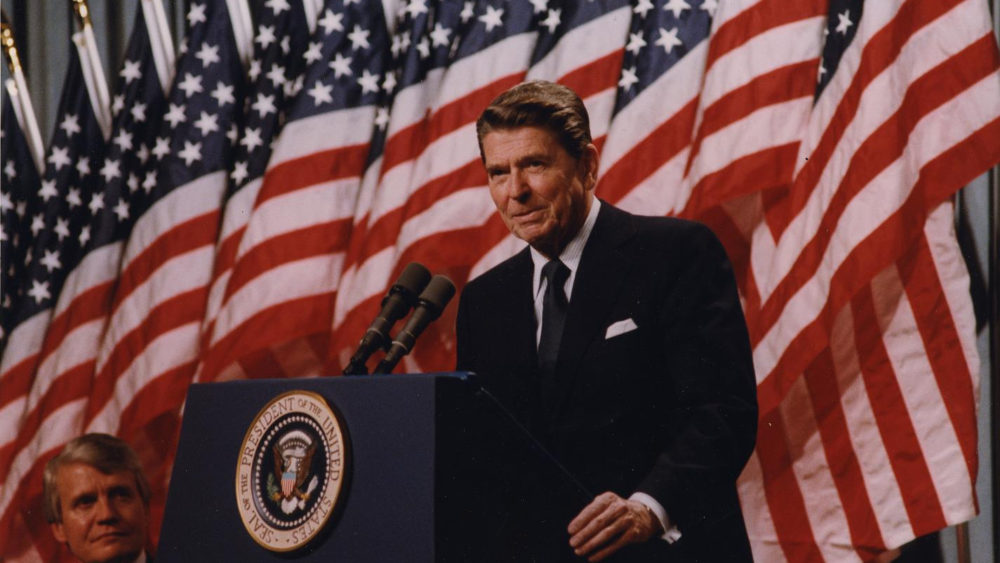Introduction
In the 1980s, President Ronald Reagan rode the wave of a powerful political movement often referred to as the “New Right,” to contrast the more moderate brand of conservatism popular prevalent after World War II. By the 1980s, the New Right had evolved into the most influential wing of the Republican Party and could claim significant credit for its electoral successes. Building upon the gradual unraveling of the New Deal political order in the 1960s and 1970s, the conservative movement not only enjoyed the guidance of skilled politicians like Reagan, but drew tremendous energy from a broad range of grassroots activists. Countless ordinary citizens–newly mobilized Christian conservatives, in particular–helped the Republican Party steer the country onto a rightward course. American politics would increasingly be fought on terrain chosen by the New Right. The following sources explore the range of conservative thought and influence in the 1980s and beyond.
Documents
1. First Inaugural Address of Ronald Reagan (1981)
Ronald Reagan, a former actor, corporate spokesperson, and California governor, won the presidency in 1980 with a potent mix of personal charisma and conservative politics. In his first inaugural address, Reagan famously declared that “government is not the solution to our problem; government is the problem.”
2. Jerry Falwell on the “Homosexual Revolution” (1981)
“Letter from Jerry Falwell on his opposition to homosexuality and asking for support in keeping his “Old-Time Gospel Hour” television program on the air. Falwell writes that the Old Time Gospel Hour “is one of the few major ministries in America crying out against militant homosexuals” (p. 1). The letter is printed on what appears to be lined yellow notepad paper.”
3. Statements of AIDS Patients (1983)
HIV/AIDS confronted Americans in the 1980s. The disease was first associated with gay men (it was initially called Gay-Related Immune Disease, or GRID) and AIDS sufferers fought for recognition of the disease’s magnitude, petitioned for research funds, and battled against popular stigma associated with the disease.
4. Statements from The Parents Music Resource Center (1985)
In 1985, the Senate held hearings on explicit music. The Parents Music Resource Center (1985), founded by the wives of prominent politicians in Washington D.C., publicly denounced lyrics, album covers, and music videos dealing with sex, violence, and drug use. The PRMC pressured music publishers and retailers and singled out artists such as Judas Priest, Prince, AC/DC, Madonna, and Black Sabbath, and Cyndi Lauper. The following is extracted from statements by Susan Baker, the wife of then-Treasury Secretary James Baker, and Tipper Gore, wife of Senator and later Vice President Al Gore, in support of warning labels on music packaging.
5. Pat Buchanan on the Culture War (1992)
Pat Buchanan was a conservative journalist who worked in the Nixon and Reagan administrations before running for the Republican presidential nomination in 1992. Although he lost the nomination to George H.W. Bush, he was invited to speak at that year’s Republican National Convention, where he delivered a fiery address criticizing liberals and declaring a “culture war” at the heart of American life.
6. Phyllis Schlafly on Women’s Responsibility for Sexual Harassment (1981)
Conservative activist Phyllis Schlafly fought against feminism and other liberal cultural trends for decades. Perhaps most notably, she led the campaign against the Equal Rights Amendment, turning what had seemed an inevitability into a failed effort. Here, she testified before Congress about what she saw as the largely imagined problem of sexual harassment.
7. Jesse Jackson on the Rainbow Coalition (1984)
After a groundbreaking yet unsuccessful campaign to capture the Democratic Party’s nomination for president, Jesse Jackson delivered the keynote speech at the 1984 Democratic National Convention in San Francisco. He had campaigned on the idea of a “rainbow coalition,” a political movement that drew upon the nation’s racial, religious, and economic diversity. He echoed that theme in his convention speech.
Media
Satellites Imagined in Orbit (1981)

An artist’s concept of various communications satellites in orbit; 11/23/1981. Via National Archives (ID: 6364532).
While Cold War fears still preyed upon Americans, satellite technology and advancements in telecommunications inspired hopes for an interconnected future. Here, an artist in 1981 depicts various satellites in orbit around the Earth.
Ronald Reagan and the American Flag (1982)
President Ronald Reagan, a master of the “photo op,” appears here with a row of American flags at his back at a 1982 rally for Senator David Durenberger in Minneapolis, Minnesota.

